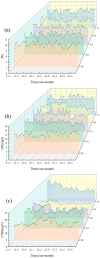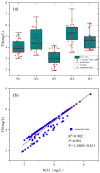Microbial Community Responses and Nitrogen Cycling in the Nitrogen-Polluted Urban Shi River Revealed by Metagenomics
- PMID: 40431180
- PMCID: PMC12114610
- DOI: 10.3390/microorganisms13051007
Microbial Community Responses and Nitrogen Cycling in the Nitrogen-Polluted Urban Shi River Revealed by Metagenomics
Abstract
Nitrogen pollution in urban rivers, exacerbated by rapid urbanization, poses a growing threat to water quality. Microbial communities are essential in mediating nitrogen cycling and mitigating pollution in these ecosystems. This study integrated three-year (2021-2023) water quality monitoring with metagenomic sequencing to investigate microbial community dynamics, nitrogen cycling processes, and their responses to nitrogen pollution in the Shi River, Qinhuangdao, China. Nitrogen pollution was predominantly derived from industrial discharges from enterprises in the Shi River Reservoir upstream (e.g., coolant and chemical effluents), agricultural runoff, untreated domestic sewage (particularly from catering and waste in Pantao Valley), and livestock farming effluents. Total nitrogen (TN) concentrations ranged from 2.22 to 6.44 mg/L, exceeding China's Class V water standard (2.0 mg/L, GB 3838-2002), with the highest level at the urbanized W4 site (6.44 mg/L). Nitrate nitrogen (NO3-N) accounted for 60-80% of TN. Metagenomic analysis revealed Fragilaria, Microcystis, and Flavobacterium thriving (up to 15% relative abundance) under nitrogen stress, with nitrogen metabolism genes (narG, nifH, nirK) enriched at polluted sites (W2, W4), narG reaching 26% at W1. Dissolved oxygen positively correlated with nitrate reductase gene abundance, while ammonia nitrogen inhibited it. Burkholderiales and Limnohabitans dominated denitrification, offering insights into sustainable urban river management.
Keywords: Shi River; denitrification; metagenomics; microbial community; narG; nitrogen pollution.
Conflict of interest statement
The authors declare no conflicts of interest.
Figures











Similar articles
-
Metagenomic insights into nitrogen-cycling microbial communities and their relationships with nitrogen removal potential in the Yangtze River.Water Res. 2024 Nov 1;265:122229. doi: 10.1016/j.watres.2024.122229. Epub 2024 Aug 8. Water Res. 2024. PMID: 39154395
-
[Effects of Nitrogen Speciation Transformation on Microbial Community Succession in Input Rivers of Miyun Reservoir].Huan Jing Ke Xue. 2023 Sep 8;44(9):4985-4995. doi: 10.13227/j.hjkx.202210192. Huan Jing Ke Xue. 2023. PMID: 37699816 Chinese.
-
Sources and transformations of anthropogenic nitrogen in the highly disturbed Huai River Basin, Eastern China.Environ Sci Pollut Res Int. 2019 Apr;26(11):11153-11169. doi: 10.1007/s11356-019-04470-1. Epub 2019 Feb 22. Environ Sci Pollut Res Int. 2019. PMID: 30796665
-
Integrative study of microbial community dynamics and water quality along The Apatlaco River.Environ Pollut. 2019 Dec;255(Pt 1):113158. doi: 10.1016/j.envpol.2019.113158. Epub 2019 Sep 3. Environ Pollut. 2019. PMID: 31521989
-
Understanding nitrate dynamics in urbanized and forested river ecosystems: A study integrating natural-abundance and paired isotopes.J Environ Manage. 2025 Apr;380:125073. doi: 10.1016/j.jenvman.2025.125073. Epub 2025 Mar 22. J Environ Manage. 2025. PMID: 40120453
References
-
- Soni H., Yadav R.K., Patra S.K. Global impact of urbanization on ecosystems: A comprehensive bibliometric analysis. Nat. Hazards Res. 2024;5:21–35. doi: 10.1016/j.nhres.2024.04.001. - DOI
-
- Usman M., Sanaullah M., Ullah A. Nitrogen pollution originating from wastewater and agriculture: Advances in treatment and management. Rev. Environ. Contam. 2022;260:9. doi: 10.1007/s44169-022-00010-0. - DOI
Grants and funding
- LH2022C098/Research Grants of Nature Scientific Foundation of Heilongjiang Province
- ES202217/the 2022 Open Fund of National Key Laboratory of Urban Water Resources and Water Environ-ment
- 2023-KYYWF-1495/Basic Research Business Fees for Provincial Higher Education Institutions in Heilongjiang Prov-ince
LinkOut - more resources
Full Text Sources

